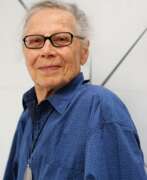Europe Contemporary art
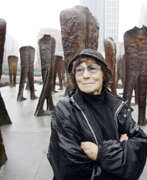

Magdalena Abakanowicz was a distinguished Polish artist, celebrated for her innovative use of textiles as a sculptural medium. Born on June 20, 1930, in Falenty, Poland, and passing away on April 20, 2017, in Warsaw, she carved out a significant place in the art world with her unique artistic expressions that often explored themes of crowd behavior, the trauma of war, and the individuality of the human condition.
Abakanowicz's education at the Academy of Fine Arts in Warsaw was a period of both artistic and personal growth, shaping her future works. During the 1960s, she began creating the "Abakans," large-scale textile sculptures that challenged conventional forms and expressed dynamic movement and vivid emotion. Her works often featured organic, tactile materials like burlap, resin, and wood, which added a profound depth and rawness to her sculptures.
Her sculptures are well-represented in major public installations and collections worldwide, including the National Museum in Wrocław, Poland, Grant Park in Chicago, and the National Gallery of Art Sculpture Garden in Washington, D.C. These pieces are not just art forms but are experiences, inviting viewers to explore deeper psychological and existential themes.
For those captivated by the profound impact and the stirring beauty of Magdalena Abakanowicz's work, subscribing for updates can provide regular insights and information on exhibitions and sales of her works at auctions. This is an excellent way to stay connected with the legacy of an artist who continuously redefined the boundaries of sculpture and installation art.
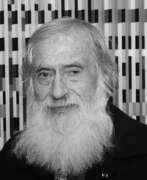

Yaacov Agam, an Israeli kinetic and optical artist born on May 11, 1928, is celebrated for revolutionizing the visual arts with his dynamic and interactive creations. Agam's pioneering work extends beyond traditional static art forms, inviting viewers into a transformative experience that changes with perspective and movement. His art, deeply rooted in his Jewish heritage and mysticism, eschews representational imagery for abstract, geometric forms and vibrant colors, engaging the observer's perception to complete the visual experience.
Notably, Agam's contributions to kinetic art have not only garnered him international acclaim but also led to his works commanding the highest prices among Israeli artists at auction. His innovative "Agamographs" use lenticular printing to create illusions of depth and motion, highlighting his fascination with the interplay between art, viewer, and the temporal dimension. Agam's significant exhibitions include retrospectives at the Musée National d'Art Moderne in Paris and the Guggenheim Museum in New York. His achievements are further recognized through multiple awards and the establishment of the Yaacov Agam Museum of Art in his hometown of Rishon LeZion, Israel, dedicated to his vision of art in motion.
For collectors and art and antiques experts, Agam's work represents a profound exploration of perception, time, and spirituality, offering a unique and engaging experience. His art invites us to see beyond the visible, reminding us of the ever-changing nature of reality and our active role in its perception. To stay updated on new product sales and auction events related to Yaacov Agam, sign up for updates and immerse yourself in the dynamic world of one of the most influential modern artists.
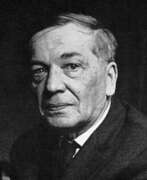

Mikhail Fedorovich Andrienko-Nechytailo (Russian: Михаил Фёдорович Андриенко-Нечитайло) was a Russian artist known for his contributions to the avant-garde movement. Born in 1894, he became renowned for his innovative approach to painting, stage design, and illustration. Andrienko-Nechytailo’s work is celebrated for its unique blend of Constructivism and Cubism, which set him apart from his contemporaries.
One of his special features was his ability to combine geometric forms with a vibrant color palette, creating visually striking compositions that challenged traditional artistic conventions. His works often explored themes of abstraction and the intersection of art and technology. His notable pieces are housed in prestigious collections, including the Tretyakov Gallery in Moscow and the Russian Museum in Saint Petersburg.
Collectors and art experts admire Andrienko-Nechytailo for his visionary approach and lasting impact on modern art. His legacy continues to influence contemporary artists and is a testament to his skill and creativity.
Sign up for updates on new product sales and auction events related to Mikhail Fedorovich Andrienko-Nechytailo. Stay informed about opportunities to add his remarkable works to your collection.
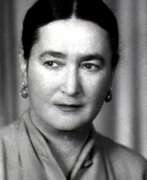

Mariam Arshaki Aslamazyan (Russian: Мариам Аршаковна Асламазян) was a renowned Soviet-Armenian painter, often hailed as the "Armenian Frida Kahlo" due to her vibrant and expressive works that prominently featured elements of Armenian culture. Born on October 20, 1907, in Alexandropol (now Gyumri), Armenia, Aslamazyan was celebrated for her unique style which blended traditional Armenian themes with modernist influences.
Throughout her career, Aslamazyan's artwork received significant accolades, including the prestigious titles of People's Artist of the Armenian SSR in 1965 and People's Artist of the Soviet Union in 1990. Her paintings are characterized by their vivid colors and dynamic compositions, often focusing on still lives, narrative scenes, and portraits.
Aslamazyan's works are preserved and displayed in several major collections, notably at the Gallery of Mariam and Eranuhi Aslamazyan Sisters in her hometown, which showcases an extensive array of her oil paintings and ceramic works. Her artistic legacy continues to be celebrated in exhibitions and holds a significant place in Armenian cultural heritage.
For those interested in exploring more about Mariam Arshaki Aslamazyan's life and art, or in acquiring works associated with her, consider subscribing for updates on new product sales and auction events related to her work. This subscription will keep you informed about opportunities to engage with Aslamazyan's art legacy.


Bernard Buffet was a French artist renowned for his distinctive style of painting, printmaking, and sculpture. His work, characterized by expressive, angular lines and somber themes, has captivated collectors and art enthusiasts worldwide. Buffet's art, deeply influenced by the post-war period in France, reflects themes of despair, loneliness, and the human condition, often portrayed through his iconic clowns and desolate landscapes. His approach to art, marked by stark compositions and a vivid portrayal of existential angst, positioned him as a leading figure in the modern expressionist movement.
Buffet's career was meteoric from its onset; by his early twenties, he was celebrated alongside cultural icons of the time, earning him a spot among the "Fabulous Five" of post-war France. Despite his early acclaim, Buffet's later years were marked by controversy and a decline in popularity, as shifts in artistic trends and criticism over his lifestyle choices overshadowed his contributions. Nevertheless, his work remained prolific, with more than 8,000 paintings to his name, illustrating an unwavering commitment to his art until his tragic death in 1999.
Today, Bernard Buffet's legacy is undergoing a renaissance, with a renewed appreciation for his artistic achievements. Exhibitions and retrospectives across the globe, particularly in Japan and Europe, have reignited interest in his oeuvre, showcasing the enduring relevance of his work. Notably, the Bernard Buffet Museum in Japan, founded during his lifetime, stands as a testament to his impact and the global admiration for his art.
For collectors and experts in the field of art and antiques, Buffet's work offers a unique insight into the complexities of the human psyche and the existential dilemmas of the 20th century. His ability to evoke profound emotional responses through his distinctive visual language makes his work highly sought after in the art market today.
To stay informed about new product sales and auction events related to Bernard Buffet, we encourage you to sign up for updates. This subscription service is tailored specifically for enthusiasts keen on exploring the profound legacy of Bernard Buffet, ensuring you remain at the forefront of notable developments in the art world.
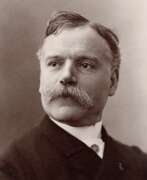

Jules Chéret, a French artist and lithographer, revolutionized the world of advertising and poster art in the late 19th and early 20th centuries. Born in Paris in 1836, Chéret's innovative techniques and vibrant style earned him the title of "the father of the modern poster," a distinction that highlights his significant contributions to the graphic arts. His work was greatly influenced by the Rococo movement, drawing inspiration from artists like Jean-Honoré Fragonard and Antoine Watteau, which is evident in his joyful and lively representations of women, known as 'Chérettes.' These figures broke away from traditional depictions, celebrating femininity with elegance and a sense of freedom, thereby contributing to a more open atmosphere in Parisian society.
Chéret's mastery of lithography, a printing technique he believed would dominate over traditional letterpress, allowed for the production of colorful and dynamic posters. His approach to lithography was revolutionary; he simplified the chromolithographic process by using three primary colors and treated the limestone with a painterly technique that included animated brush lines and soft washes. This enabled him to produce posters that were not only advertisements but also highly regarded pieces of art. His first major commission came in 1858 for Jacques Offenbach's "Orpheus in the Underworld," marking the beginning of a prolific career that would redefine poster art.
Chéret's legacy is vast, with his works now coveted by collectors and art enthusiasts around the world. In 1895, he created the "Maîtres de l'Affiche" collection, which featured smaller reproductions of the best works by ninety-seven Parisian artists, further cementing his impact on the art world. His influence extended to inspiring a new generation of artists, including Henri de Toulouse-Lautrec and Charles Gesmar. Despite his passing in 1932 in Nice, Chéret's contributions to art and culture remain celebrated, and his innovative posters continue to be a source of fascination and admiration.
For collectors and experts in art and antiques, Chéret's work represents a pivotal moment in the history of graphic design and advertising, blending artistic merit with commercial appeal in a way that was groundbreaking for its time. His posters, characterized by vibrant colors, dynamic compositions, and a distinctively cheerful and liberated portrayal of women, offer a glimpse into the cultural and social milieu of Belle Époque Paris.
If you're intrigued by Jules Chéret's work and wish to explore more about his contributions to art and advertising, consider signing up for updates on new product sales and auction events related to his work. This subscription will provide you with the opportunity to deepen your understanding of Chéret's legacy and perhaps even add a piece of his history-making art to your collection.
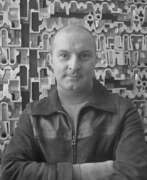

Armand Pierre Fernandez, widely known by his mononym Arman, was a French-born American artist celebrated for his innovative contributions to the Nouveau Réalisme movement and his radical use of everyday objects in art. Born in Nice, France, on November 17, 1928, Arman's early exposure to art came from his father, an antiques dealer and amateur artist, which deeply influenced his later artistic endeavors.
Arman moved beyond traditional painting techniques early in his career, instead creating his signature "Accumulations" and "Poubelles" (trash) sculptures. These works involved assembling and compacting everyday items like watches, clocks, and even automobiles, embedding these objects in layers of concrete or encasing them in Plexiglas. One of his most notable large-scale works is "Long Term Parking," a 60-foot high sculpture made of concrete-encased cars, situated in Jouy-en-Josas, France.
His work is an essential bridge between European and American trends in Pop art and has been widely exhibited in major institutions like the Metropolitan Museum of Art in New York, the Tate Gallery in London, and the Centre Pompidou in Paris. Arman's innovative techniques and philosophical approach to materials challenged conventional categorizations of art and inspired future generations of artists.
For collectors and enthusiasts interested in staying updated on exhibitions and sales related to Arman's work, signing up for updates can provide essential insights and opportunities related to this influential artist. Join our community to ensure you don't miss out on new discoveries and auction events associated with Arman's legacy.
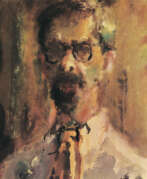

Arthur Vladimirovich Fonvizin (Russian: Артур Владимирович Фонвизин), a Soviet painter renowned for his mastery in watercolor, was born on January 11, 1883, into a forester's family. From a young age, following a transformative experience at a circus, Fonvizin developed a profound love for drawing. His journey into the art world began with his education at the Moscow School of Painting, where he rubbed shoulders with avant-garde artists and later furthered his studies in Munich among a vibrant community of Russian painters. Fonvizin's early work, influenced by symbolism and the lyrical primitive style, included notable pieces such as "The Bride" (1902) and "Leda" (1904).
Throughout his career, Fonvizin was an active participant in significant art movements and exhibitions, such as the Blue Rose, Jack of Diamonds, and the World of Art movement. His transition to watercolors marked a defining moment in his artistic journey, allowing him to capture the ephemeral beauty of landscapes, portraits, and scenes from pre-revolutionary life with a directness and vibrancy that became his hallmark.
Despite facing challenges, including criticism for formalism and being exiled due to his German heritage, Fonvizin's resilience and dedication to art remained unwavering. His works, celebrated for their lack of preparatory sketches and immediate application of paint, are held in high esteem and featured in prestigious collections like the Tretyakov Gallery and the Pushkin Museum. Among his famous works are "The Circus. Horsewoman" (1936) and portraits of ballerinas from the Bolshoi Theater, showcasing his lifelong fascination with the circus and theater.
For collectors and experts in art and antiques, Fonvizin's oeuvre offers a unique glimpse into the soul of early 20th-century Russian art, marked by its lyrical beauty and emotional depth. To stay updated on sales and auction events related to Arthur Vladimirovich Fonvizin's work, signing up for updates is recommended. This subscription ensures access to the latest information on the availability of his mesmerizing watercolor paintings.
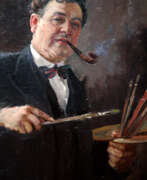

Aleksandr Mikhailovich Gerasimov (Russian: Алекса́ндр Миха́йлович Гера́симов) was a Russian and Soviet painter, born on August 12, 1881, in Kozlov (now Michurinsk), in the Tambov Governorate of the Russian Empire. He is best recognized for his leading role in promoting socialist realism in visual arts, notably through his portraits of Joseph Stalin and other Soviet leaders. Gerasimov's education at the Moscow School of Painting, Sculpture, and Architecture honed his skills, guided by masters like K.A. Korovin, A.E. Arkhipov, and V.A. Serov. His style, a blend of academic realism with impressionistic influences, vividly depicted the Russian landscape, leaders, and the daily life of the Soviet era.
His works, rich in emotionality and composition mastery, span across various themes from state portraits to landscapes and still lifes, showcasing a deep love for the Russian landscape's innate beauty. Gerasimov's contributions to art include not only significant political portraits but also captivating scenes of nature and life in Russia, marked by their emotional depth and vibrant colors. His paintings like "Stalin and Voroshilov in the Kremlin" won him the Stalin Prize in 1941, cementing his status in Soviet art history.
Gerasimov's artistry extends beyond his political work; his landscapes and portrayals of Russian expanses convey a deep lyrical sentiment, reflecting his profound connection and love for his homeland. His mastery across various mediums—oil, watercolor, gouache, and more—allowed him to explore and express a wide range of subjects, from portraits and landscapes to still lifes, showcasing his versatility and depth as an artist.
For those interested in the intersection of art and history, Aleksandr Mikhailovich Gerasimov's work offers a fascinating window into Soviet-era Russia, its leaders, and its landscapes. To stay updated on exhibitions and sales of Gerasimov's works, sign up for updates specifically focused on new product sales and auction events related to this distinguished artist.


Ilya Sergeyevich Glazunov (Russian: Илья́ Серге́евич Глазуно́в) was a distinguished Soviet and Russian artist, born on June 10, 1930, in Leningrad, and passing away on July 9, 2017, in Moscow. Glazunov was not just a painter; he was a visionary and an educator who founded the Russian Academy of Painting, Sculpture, and Architecture in Moscow, where he also served as rector until his death. Glazunov's artistry was deeply rooted in historical and religious themes, as seen in masterpieces like Russia the Eternal, The 20th Century Mystery, and The Ruining of the Temple on Easter Night, along with his celebrated illustrations for Fyodor Dostoyevsky's works.
Glazunov's contribution to Russian art and culture was immense. He was a full cavalier of the Order "For Merit to the Fatherland," among other honors, acknowledging his significant role in the national art scene and education. Notably, during the 1970s, Glazunov played a key role in saving parts of Moscow's historic center from destruction due to proposed restoration plans, showcasing his commitment not only to the arts but also to preserving Russia's cultural heritage.
Collectors and experts in art and antiques admire Glazunov for his unique blend of artistic brilliance and dedication to cultural preservation. His works, which are held in high esteem across the globe, are a testament to his skill, vision, and unwavering love for his homeland. For those intrigued by Glazunov's legacy and wishing to explore his works further, subscribing for updates on new sales and auction events related to Ilya Sergeyevich Glazunov is highly recommended. This subscription is an invaluable resource for staying informed about opportunities to own a piece of Russian art history.
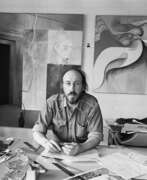

Richard William Hamilton was a pivotal figure in the evolution of modern art, seamlessly blending traditional mediums with emerging cultural commentary. Born in London in 1922, Hamilton emerged as a leading voice in the pop art movement, a genre that sought to bridge the gap between high art and popular culture. His work, characterized by its innovative use of materials and its critical eye on consumer society, positioned him as a critical link between art's past and its rapidly evolving future.
Hamilton's influence is perhaps best encapsulated in his iconic collage, "Just what is it that makes today's homes so different, so appealing?" Created for the This Is Tomorrow exhibition in 1956, this piece is widely regarded as one of the first works of pop art, predating the more widely recognized contributions of American artists like Andy Warhol and Roy Lichtenstein. By integrating images from magazines, advertisements, and other mass media, Hamilton crafted a visually striking critique of contemporary consumerism and its pervasive impact on the domestic sphere.
Beyond his contributions to pop art, Hamilton's legacy is also preserved in his role as an educator and theorist. His writings and teachings have influenced generations of artists, encouraging them to explore the intersections of art, technology, and society. His works are held in high esteem and are featured in prestigious collections worldwide, including the Tate Gallery in London and the Museum of Modern Art in New York.
For collectors and experts in art and antiques, Hamilton's oeuvre offers a fascinating window into the mid-20th century's cultural shifts. His ability to capture the zeitgeist of his time, while also pushing the boundaries of what art could be, makes his work both historically significant and continually relevant.
To stay informed about new product sales and auction events related to Richard William Hamilton, we invite you to sign up for updates. This subscription ensures you remain at the forefront of the art and antiques world, with a focus on one of its most influential figures.
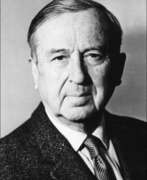

Mykola Petrovich Hlushchenko, a prominent Ukrainian post-impressionist painter, was born in 1901 in Novomoskovsk, Russia, and is celebrated for his diverse artistic contributions that span across various European landscapes, still life, nudes, and notable portraits. His early exposure to art in Yuzivka (now Donetsk), and further education at the Academy of Art in Berlin in 1924, laid the foundation for his illustrious career. Hlushchenko's work caught the attention of French critics soon after he moved to Paris in 1925, marking his transition from the New Objectivity style to post-Impressionism.
Hlushchenko's involvement with the Association of Independent Ukrainian Artists in the early 1930s, and his exhibitions across major European cities and the United States, underscored his role as a leading figure in Ukrainian post-impressionism. His work was characterized by vibrant color use and a unique blend of styles influenced by his time in Germany, France, and later in the Soviet Union. Throughout his life, Hlushchenko's art reflected his extensive travels and deep appreciation for landscapes, earning him numerous awards including the Shevchenko National Prize in 1972.
For art collectors and enthusiasts, Hlushchenko's pieces not only represent the zenith of Ukrainian post-impressionism but also embody the artist's rich, multifaceted life experiences. His paintings, such as the portraits of Oleksandr Dovzhenko and Volodymyr Vynnychenko, along with commissioned works for the Soviet government, showcase his adaptability and mastery over his medium.
To stay informed on Mykola Petrovich Hlushchenko's works and related auction events, signing up for updates is advisable. This subscription ensures you're always in the loop for new sales and exhibitions, enriching your collection with the vibrant legacy of a distinguished Ukrainian artist.
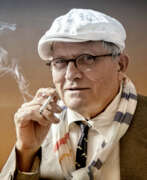

David Hockney, a British artist, has been a prominent figure in the art world for over six decades, renowned for his contributions to painting, drawing, printmaking, photography, and video art. His exploration of these mediums has made significant impacts on the Pop Art movement and beyond, making him one of the most influential artists of the 20th and 21st centuries. Hockney's work is celebrated for its vibrant color palette, emotional depth, and innovative use of technology in art.
One of Hockney's most distinctive features is his ability to blend traditional techniques with modern technology, notably in his iPad drawings and photographic collages. This fusion not only showcases his skillful adaptation to contemporary mediums but also highlights his ongoing quest to explore the nature of seeing and representation in art. Hockney's landscapes and portraits, characterized by their bright colors and meticulous detail, invite viewers to see the world through his unique perspective.
Significant works by Hockney, such as "A Bigger Splash" and "Portrait of an Artist (Pool with Two Figures)," are housed in major museums and galleries worldwide, attesting to his global influence and appeal. These pieces, among others, demonstrate Hockney's mastery over space, light, and narrative, securing his position as a pivotal figure in modern and contemporary art.
For collectors and experts in art and antiques, Hockney's oeuvre presents a fascinating study in the evolution of visual arts. His work not only offers insight into the artist's personal vision but also reflects broader cultural and technological shifts in society. As interest in Hockney's art continues to grow, keeping abreast of new sales and auction events becomes increasingly valuable.
To stay informed about the latest David Hockney sales and auction events, sign up for our updates. This subscription ensures that you receive timely notifications about new product sales and auction events related to David Hockney, offering unique opportunities for collectors and enthusiasts alike.
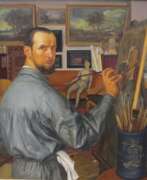

Aleksandr Evgenevich Iakovlev (Russian: Александр Евгеньевич Яковлев), a Russian painter, graphic artist, and designer, left an indelible mark on the world of art with his unique blend of classical and orientalist styles. Born in Saint Petersburg, Russia, in 1887, Iakovlev was part of the vibrant Russian artistic community that contributed significantly to the neo-classical and orientalist movements. His extensive travels across Mongolia, China, Japan, Africa, Syria, Iran, and Afghanistan enriched his art, leading to a prolific output of portraits, landscapes, still lifes, and figure compositions that combined elements of Italian Renaissance with Russian Primitivism.
Iakovlev's early involvement with the Mir Iskusstva exhibition in 1915 showcased his talent but also highlighted the mixed reactions from critics and the Academy of Arts, signaling his departure from traditional academic confines. His scholarship to study in the Far East and subsequent travels profoundly influenced his work, as seen in his orientalist paintings and ethnographic drawings. This period of exploration culminated in his significant contributions as an official artist on the Citroën expeditions across Central Africa and Asia, where he captured the essence of the diverse cultures he encountered.
His works, such as "Three Women in a Box at the Theatre" and his participation in designing the Prival Komediantov artistic cabaret, exemplify his mastery of merging traditional subjects with a modernist touch. Serving as the Director of the Painting Department at the School of the Museum of Fine Arts, Boston, between 1934 and 1937, Iakovlev influenced the art scene beyond the Russian borders before his death in Paris in 1938.
Iakovlev's legacy is preserved in museums and galleries worldwide, celebrating his contributions to bridging cultures through art. His ability to document his travels and experiences in such a vivid and artistic manner has left a lasting impact on the appreciation of cultural diversity in the art world.
For collectors and experts in art and antiques, Aleksandr Evgenevich Iakovlev's works represent a convergence of classical artistry and exploratory zeal, making them highly sought after. His pieces not only capture the beauty of the subjects he portrayed but also serve as a window into the cultures and landscapes that inspired him.
For updates on exhibitions and auction events featuring Aleksandr Evgenevich Iakovlev's works, sign up to stay informed about new discoveries and opportunities to add to your collection.
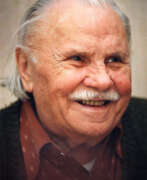

Vladimir Alexandrovich Igoshev (Russian: Владимир Александрович Игошев) was a renowned Russian painter, celebrated for his contributions to realism and his vivid portrayals of the northern regions of Russia. Born in 1921 in Bashkiria, Igoshev embarked on his artistic journey at the Theatrical Arts College in Ufa, followed by his graduation from the Moscow State Art Institute named after V.I. Surikov in 1950.
Igoshev's work is distinguished by its focus on the lives and environments of the nomadic reindeer herding cultures in Siberia, often encapsulating the stark, raw beauty of the Russian North. His series on this theme stands out as a significant part of his legacy. His artistic merit earned him the titles of People's Artist of the RSFSR in 1965 and People's Artist of the USSR in 1991. His achievements were further recognized with the State Prize of the RSFSR named after I.E. Repin in 1982.
His artworks are featured in prominent collections, including the State Tretyakov Gallery, the Russian Museum, and various regional museums. Additionally, a personal museum dedicated to his works was established in Khanty-Mansiysk in 2001, underscoring his impact and continued relevance in the art world.
For collectors and enthusiasts interested in exploring the depth of Russian realism and Igoshev's unique interpretations of cultural landscapes, staying updated on exhibitions and auction events can provide valuable insights into his artistic contributions. To receive updates related to Vladimir Alexandrovich Igoshev, consider signing up for notifications about new product sales and auction events.
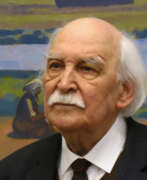

Victor Ivanovich Ivanov (Russian: Виктор Иванович Иванов) was a distinguished Russian painter, recognized for his significant contributions to the "severe style" of painting, a movement that emerged post-World War II. Born on August 2, 1924, in Moscow, Ivanov was an ardent student of art from a young age, training at notable institutions such as the Moscow secondary art school V. I. Surikov and the Moscow Government Art Institute V. I. Surikov.
Ivanov's works often revolve around the themes of rural life and the connection between humans and nature, depicting the life of peasants and their interaction with their environment. His painting "Women Harvesting" is an exemplary work that showcases his style and thematic focus. This piece, which is part of the Tretyakov Gallery's collection, epitomizes Ivanov's ability to blend colors and forms to capture the essence of peasant life, with a particular emphasis on the harmony and solemnity of rural labor.
Throughout his career, Ivanov's art was celebrated not only in the Soviet Union but also internationally, with exhibitions across Russia, Ukraine, and even in Cuba. His artistic philosophy was deeply rooted in realism, through which he believed one could express the spiritual and moral values of the common people. Ivanov's contributions to art were recognized with numerous awards, including the title of People's Artist of the USSR and membership in the Russian Academy of Arts.
For collectors and enthusiasts interested in the profound and evocative works of Victor Ivanovich Ivanov, staying informed about upcoming sales, exhibitions, and auction events is essential. Subscribe for updates exclusively related to Ivanov's works, ensuring you never miss an opportunity to engage with the legacy of this influential artist.
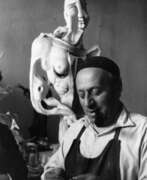

Yervand Kochar (Russian: Ерванд Семёнович Кочар) was an Armenian sculptor and modern artist, renowned for his groundbreaking contributions to the 20th-century art world, particularly as a pioneer of the Painting in Space art movement. Born in Tbilisi, Georgia, in 1899, Kochar's artistic journey led him from his native land to Paris, where his innovative works earned him critical acclaim and a place alongside other avant-garde artists. His creations, characterized by a dynamic blend of sculpture and painting, sought to introduce time as a fourth dimension to art, presenting a novel way of perceiving artistic expressions.
Kochar's most celebrated works, such as the statues of David of Sassoun and Vardan Mamikonian, have become emblematic of Armenian heritage, symbolizing the enduring spirit and cultural richness of Armenia. His masterpiece in painting, "Disasters of War," alongside other significant works, underscores his versatility and mastery over different mediums. The Yervand Kochar Museum in Yerevan, Armenia, serves as a testament to his enduring legacy, housing a vast collection of his works and offering insights into his artistic evolution and the profound impact of his contributions to modern art.
For art collectors and experts, Kochar's work represents not only a pivotal moment in the history of modern art but also an opportunity to engage with the rich tapestry of Armenian cultural identity. His innovative approach to form, space, and time continues to inspire new generations of artists and art aficionados worldwide.
To stay updated on exhibitions and auctions featuring Yervand Kochar's works, sign up for updates. By subscribing, you'll receive alerts on new sales and auction events related to Kochar's art, ensuring you never miss an opportunity to engage with the legacy of this remarkable artist.
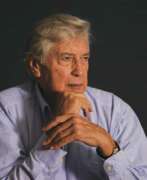

Julio Le Parc, an Argentine artist born in 1928, is celebrated for his significant contributions to modern op art and kinetic art. Educated at the School of Fine Arts in Argentina, Le Parc is a founding member of the influential Groupe de Recherche d’Art Visuel (GRAV) and has received numerous accolades for his work, cementing his status as a key figure in Argentine modern art.
Le Parc's art is renowned for its interactive nature, inviting viewers to experience his works through light, movement, and perception, rather than through narrative or representational content. His piece "Light in Movement" (1962), for example, uses painted drywall, mirrors, stainless steel, nylon thread, and spotlights to create an immersive environment of reflected and refracted light, exemplifying his focus on the sensory experience. Other notable works include "Celule Avec Luminere un Vibration" (1968), which employs light projections to create rhythmic patterns that immerse the viewer in a sensorial experience.
Le Parc's explorations extend to various series such as the "Alchemy" and "Modulation" series, where he experiments with elements like water and light to investigate movement and perception. "Alchemy 175" and "Alchemy 216," from 1991 and 1992 respectively, reflect his fascination with the transformative properties of water and light, while "Modulation 1160" (2004) is recognized for its illusion of motion, showcasing Le Parc's continuous innovation.
Julio Le Parc's works have been exhibited globally, including at prestigious venues like the Perez Art Museum Miami and the Serpentine Sackler Gallery, among others, highlighting his international acclaim and influence.
For those intrigued by the immersive and interactive qualities of Julio Le Parc's art, subscribing for updates on new product sales and auction events related to his works can offer exclusive insights and opportunities to engage with the artist's pioneering contributions to kinetic and op art.


Lazar Markovich Lissitzky (Russian: Ла́зарь Ма́ркович Лиси́цкий) was a pivotal figure in the avant-garde art movement of the early 20th century, whose contributions spanned across multiple disciplines including painting, architecture, and graphic design. Born in Pochinok, Russian Empire (now in Smolensk Oblast, Russia), Lissitzky is renowned for his profound influence on the development of Constructivism, a movement characterized by the integration of technology and industry into the arts.
Lissitzky's work is distinguished by its innovative use of geometric forms, bold colors, and dynamic compositions, which sought not only to reflect the modern industrial world but also to actively participate in shaping it. His artworks and theories were instrumental in bridging the gap between the avant-garde movements in Russia and Western Europe, facilitating a cross-cultural exchange that enriched the development of modern art. Among his most notable contributions are his "Proun" series, an acronym for "Project for the Affirmation of the New" in Russian, which encapsulates his vision of art as a transformative social force.
His legacy is preserved in some of the world's most prestigious museums and galleries, including the Museum of Modern Art in New York and the Russian State Museum in Saint Petersburg. These institutions house key works that exemplify Lissitzky's groundbreaking approach to art and design, making them a focal point for collectors and experts in the field of art and antiques.
For those deeply invested in the evolution of modern art and its profound impact on culture and society, Lissitzky's work offers invaluable insights into the creative exploration of form and space. His contributions continue to inspire contemporary artists and designers, emphasizing the enduring relevance of his vision.
We invite collectors and art experts to sign up for updates on new product sales and auction events related to Lazar Markovich Lissitzky. This subscription is an opportunity to stay informed about the latest acquisitions and offerings that celebrate the legacy of a visionary artist whose work continues to resonate with audiences worldwide.
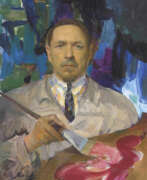

Filipp Andreevich Malyavin (Russian: Филипп Андреевич Малявин) was a Russian artist whose journey from a novice in a monastery to a renowned painter in Europe is as vibrant and eccentric as his artworks. Born into a poor peasant family in the village of Kazanka, Samara province, Malyavin's early fascination with art propelled him from creating clay figurines and drawings in his village to studying under the tutelage of Ilya Repin at the Saint Petersburg Academy of Arts. His unique approach to painting, characterized by large canvases, the bold use of the color red, and dynamic brushstrokes, distinguished his work from his contemporaries.
Malyavin's most notable early works include "Peasant Girl Knitting a Stocking" and "Laughter," the latter of which, despite initial criticism for its unconventional portrayal of Russian women, earned him a gold medal in Paris and was acquired by the Museo d'arte moderno in Venice. His portraits, such as those of Baroness Wolf and Mme. Popova, along with his depiction of peasant life, brought him fame both in Russia and abroad.
His art reflects the rich colors and patterns of the traditional clothes of the Kazanka peasants, bringing a sense of cheerfulness and vitality that transcended the somber reality of peasant life. His work "Three Babas" exemplifies this style, capturing the women in vibrant attire against a rural backdrop, conveying a sense of nostalgia for his homeland after his emigration in 1922.
For collectors and experts in art and antiques, Malyavin's works offer a unique glimpse into the soul of Russian peasant life, infused with an exuberance and color that set them apart from the works of his peers. His pieces, such as "Whirlwind," "Laughter," and "Peasant Women," are celebrated for their distinctive style and emotional depth, making them valuable additions to any collection.
To stay updated on sales and auction events related to Filipp Andreevich Malyavin, sign up for updates. This subscription will ensure you're the first to know about new opportunities to acquire pieces by this distinguished artist, whose work captures the spirit of Russian culture with unparalleled vibrancy and emotion.


Sergey Vasilyevich Malyutin (Russian: Сергей Васильевич Малютин) was a distinguished Russian painter, architect, and designer, celebrated for his multifaceted contributions to the world of art and design. Born in Moscow in 1859 to a merchant family, Malyutin's artistic journey began after an exhibition by the Peredvizhniki inspired him to pursue art. His formal education at the Moscow School of Painting, Sculpture and Architecture honed his talents, leading to a diverse career that spanned painting, set design for operas and ballets, and architectural endeavors.
Malyutin is perhaps best known internationally for designing the first matryoshka doll in 1890, a seminal work that has become an iconic symbol of Russian culture. His involvement in the Arts and Crafts Movement influenced his work, integrating traditional Russian folk motifs into his designs and paintings. Notably, his architectural designs, including the Church of the Holy Spirit in Talashkino and the Pertsov House in Moscow, showcase his dedication to the Russian Revival movement, blending fantastic folk motifs with architectural creativity.
Throughout his career, Malyutin also played a significant role in education, teaching at the Moscow School of Painting, Sculpture and Architecture and advocating for Socialist Realism. His contributions to Russian art were not limited to his creations; he was instrumental in founding the Association of Artists of Revolutionary Russia, emphasizing the importance of art in societal development.
For those interested in exploring the legacy of Sergey Malyutin, his works offer a window into the fusion of traditional Russian art with the innovative currents of his time. Collectors and experts in art and antiques will find his contributions to Russian arts and crafts, especially his role in the creation of the matryoshka doll, to be of particular interest.
To stay updated on exhibitions and auction events featuring Sergey Vasilyevich Malyutin's work, sign up for updates. This subscription is an invaluable resource for enthusiasts looking to deepen their understanding of Malyutin's impact on Russian art and design.
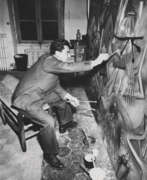

Roberto Sebastian Antonio Matta Echaurren was a Chilean artist, renowned for his significant contributions to the art world, particularly in painting and sculpture. As a figure deeply embedded in the realms of surrealism and abstract expressionism, Matta's works are celebrated for their complex, otherworldly landscapes and a profound exploration of the subconscious and architecture of the mind. His artistry is marked by fluid, organic forms and a masterful use of color, which set him apart as a visionary in the 20th century.
Matta's influence extended beyond the canvas, impacting the development of both European and American art scenes. His innovative techniques and philosophical inquiries into the nature of reality and human consciousness pushed the boundaries of traditional art forms, making him a pivotal figure among surrealists and later, abstract expressionists. Matta's work is characterized by its evocative, dream-like quality, and his ability to translate psychological concepts into visual spectacles has left a lasting legacy in the art world.
Among his renowned works, Matta's paintings are held in prestigious museums and galleries worldwide, including the Museum of Modern Art in New York and the Tate Modern in London. These institutions house pieces that showcase his unique blend of surrealism and abstract expressionism, offering art lovers and collectors a glimpse into his profound and imaginative universe. For those fascinated by the convergence of culture, art, and psychology, Matta's oeuvre presents an inexhaustible source of exploration and inspiration.
For collectors and experts in art and antiques, the legacy of Roberto Sebastian Antonio Matta Echaurren offers a rich field of discovery and appreciation. His contributions to the realms of painting and sculpture continue to resonate, providing deep insights into the capabilities of artistic expression. To stay informed about new product sales and auction events related to Matta's works, we invite you to sign up for updates. This subscription is your gateway to the latest in the world of this unparalleled artist, ensuring you never miss an opportunity to engage with the art and culture that Matta so vividly represented.
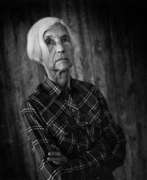

Louisa Matthíasdóttir, an Icelandic-American painter, left an indelible mark on the art world with her vibrant landscapes, portraits, and still lifes. Born in Reykjavík in 1917, Matthíasdóttir's early life in the iconic Höfði house and her exposure to the dramatic Icelandic scenery influenced her bold and clear artistic style. Her education spanned continents and artistic philosophies, studying first in Denmark, then under Marcel Gromaire in Paris, and finally under Hans Hofmann in New York City. This diverse education laid the foundation for her unique blend of realism and abstraction, characterized by simplified geometric shapes and luminous, saturated colors.
Matthíasdóttir's work, notably her Icelandic landscapes, became renowned for capturing the essence of her homeland with a distinctive clarity of light and color, despite her spending the majority of her life in the United States. Her ability to infuse the landscapes with life, often incorporating stylized figures of sheep and horses, brought a sense of warmth and immediacy to her work. Her contributions to the art world were recognized with awards and memberships, including the American-Scandinavian Foundation's Cultural Award and membership in the American Academy of Arts and Letters.
Her paintings are held in high esteem and are part of several prestigious collections, including the Hirshhorn Museum and Sculpture Garden in Washington, D.C., the Art Institute of Chicago, and the Reykjavík Art Museum. Notable exhibitions of her work include "From Unuhús to West 8th Street" at the Reykjavík Art Museum and a significant showing at the Tibor de Nagy Gallery in New York, which celebrated her Icelandic landscapes and her role in the avant-garde community both in Iceland and the United States.
For collectors and art experts, Matthíasdóttir's legacy is a testament to the power of cultural heritage and artistic innovation. Her works offer not just visual beauty but a bridge between the landscapes of Iceland and the bustling art scene of New York, reflecting a life lived between two worlds. Those interested in the intersection of culture, art, and history will find her work particularly compelling.
For updates on new product sales, auction events, and exhibitions related to Louisa Matthíasdóttir, signing up for specialized art and antique collector newsletters is highly recommended. This focused approach ensures enthusiasts and experts alike stay informed on opportunities to engage with Matthíasdóttir's influential and beautiful contributions to the world of art.
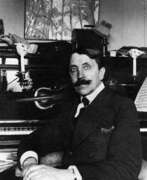

Michael Vasilyevich Matyushin (Russian: Михаил Васильевич Матюшин) was a pivotal figure in Russian art and music, known for his multifaceted talents that spanned painting, composing, and theoretical contributions to the avant-garde movement. Born in Nizhny Novgorod, Russia, in 1861, he initially made his mark as a musician, becoming the first violinist of the St. Petersburg Court Orchestra after studying at the Moscow Conservatory. Matyushin's artistic journey took a significant turn when he delved into painting, studying under various tutors and eventually meeting his future wife, Elena Guro, in an artist's studio. This partnership led to the creation of the "Crane" publishing house, fostering connections with futurists and other avant-garde artists.
Matyushin is perhaps best known for his theory of "extended seeing," which focused on the exploration of space and the interactions between color, form, and perception. This innovative approach aimed at extending the boundaries of human perception, a concept he developed further through his establishment of the Zorved group. His efforts were grounded in the belief that individuals could learn to perceive more than the visible, including information and events occurring outside their immediate sensory range.
His contributions to both the visual and musical arts culminated in notable works like the futurist opera "Victory Over the Sun," where his collaboration with Kazimir Malevich and Alexei Kruchonykh marked a significant moment in avant-garde history. After the Russian Revolution, Matyushin led an art class on Color at the Free Workshops, despite facing challenges from neoclassical revivalists. Despite these obstacles, he remained a prominent figure in Leningrad's Institute of Artistic Culture, where he continued his experimental work.
Today, Matyushin's legacy is preserved in the Museum of Avant-Garde in Saint Petersburg, housed in the very building where he lived and worked alongside other luminaries of the Russian avant-garde. For art collectors and experts, Matyushin's work represents a fascinating confluence of artistic innovation and theoretical exploration, highlighting his significant impact on both Russian art and the broader avant-garde movement.
For more insights and updates on Michael Vasilyevich Matyushin's influential works and theories, sign up for updates. This subscription will keep you informed about new product sales and auction events related to Matyushin's work, ensuring you're always at the forefront of the avant-garde art scene.
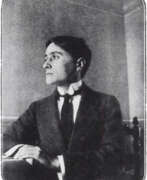

Jean Metzinger, a French Divisionist artist born in 1883, was instrumental in the development of Cubism. His approach to painting was revolutionary, challenging classical representations by emphasizing dynamism and the validity of multiple perspectives. Metzinger's early works were influenced by Neo-Impressionism, evident in his participation in exhibitions alongside Fauvist artists like André Derain and Henri Matisse. His transition to Cubism marked a significant evolution in his style, characterized by geometric simplification and an exploration of spatial complexities.
One notable work, "La Femme au Cheval," embodies Metzinger's 'mobile perspective,' a concept that mirrored the scientific advances of the time, specifically in quantum mechanics. This painting was even admired by Niels Bohr, a pioneer of quantum mechanics. Metzinger's contributions to Cubism extended beyond his paintings; he was a key figure in the movement's theoretical underpinnings, co-authoring with Albert Gleizes the first major treatise on Cubism.
Metzinger's later works ventured into greater realism and were marked by Art Deco influences, reflecting a shift towards classical beauty and balance post-World War I. This period of his work is characterized by bold colors and streamlined forms, with notable works such as "Femme au Faisan" illustrating this transition.
Metzinger's influence on modern art extends beyond his Cubist works. He was a central figure in the Parisian art scene, regularly exhibiting his work and engaging with other avant-garde artists. His legacy is preserved in museums worldwide, including significant pieces at the Albright-Knox Art Gallery and the Thyssen-Bornemisza Museum.
For collectors and experts in art and antiques, Jean Metzinger remains a pivotal figure in the history of modern art. His innovative approach to painting, theoretical contributions to Cubism, and later explorations of realism and Art Deco aesthetics offer a rich portfolio of work for appreciation and study. Sign up for updates to stay informed about new product sales and auction events related to Jean Metzinger's art.
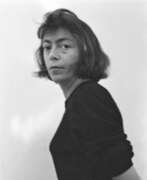

Joan Mitchell was an American painter, celebrated for her pivotal role in the Abstract Expressionist movement. Born in Chicago in 1925, Mitchell's work transcends the traditional boundaries of art, blending intense emotion with a deeply personal use of color and gesture. Her canvases are vast arenas where light, color, and texture merge to evoke landscapes, memories, and emotions. Unlike many of her contemporaries, Mitchell's art was not just about the act of painting but about capturing the essence of her experiences and emotions, making her a unique voice in 20th-century art.
Mitchell's paintings, characterized by their vibrant colors and dynamic brushstrokes, have been exhibited in some of the world's most prestigious museums and galleries. Notable works like "Hudson River Day Line" and "Bracket" found homes in institutions such as the Denver Art Museum and the San Francisco Museum of Modern Art (SFMOMA), respectively. These pieces exemplify Mitchell's ability to convey the complexity of nature and emotion, bridging the gap between abstract expressionism and the lyrical landscapes that inspired her.
Despite her critical acclaim, Mitchell's work was initially overshadowed by her male peers, selling for a fraction of their value. However, the 21st century has seen a significant reassessment of her contributions, with her paintings now commanding millions at auction. This shift is part of a broader reevaluation of women and minority artists in the art historical canon, reflecting changing perspectives on gender and creativity. Collectors and experts in art and antiques now recognize Joan Mitchell as a titan of post-war American painting, whose works continue to inspire and captivate audiences worldwide.
For those intrigued by the legacy of Joan Mitchell and the dynamic world of abstract expressionism, we invite you to sign up for updates. Our subscription service will keep you informed about new product sales and auction events related to Joan Mitchell's art, offering exclusive insights into one of the most influential artists of the 20th century.
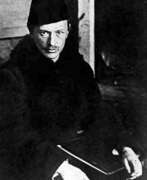

Petr Miturich (Russian: Пётр Васильевич Митурич), a Russian graphic artist and painter born in 1887 in St. Petersburg and passing away in 1956 in Moscow, was a pivotal figure in the art world of his time. His education at the Kiev art school between 1906-1909, followed by studies at the Academy of Arts in St. Petersburg under N. S. Samokish until 1915, laid a solid foundation for his career. Miturich joined the World of Art group in 1915 and was a member of the Four Arts association from 1925 to 1929, marking his active involvement in the artistic community. His teaching role at the Moscow Vkhutemas/Vkhutein between 1923 and 1930 further demonstrates his commitment to art education.
Miturich's work is celebrated for its rhythmical composition and expressive strokes, often featuring landscapes and portraits that reveal a deep engagement with both the external and internal worlds of his subjects. His innovative approach to drawing and painting, particularly evident in his portraits and cycles of landscapes, underscores his quest for a new artistic language that balanced innovation with traditional foundations.
Significantly, Miturich's contributions extend beyond his artistic creations. He was deeply interested in aeronautics, as showcased in his letun project, a testament to his engagement with the themes of flight and motion. This interest aligns him with the broader currents of Russian Modernism and connects his work with other avant-garde movements of the time.
Miturich's legacy is preserved in major institutions like the State Tretyakov Gallery, the State Russian Museum, and the Museum of Velimir Khlebnikov in Astrakhan, among others, ensuring his influential works continue to inspire art enthusiasts and collectors.
For collectors and experts in art and antiques, Petr Miturich's oeuvre offers a fascinating glimpse into the intersection of traditional art forms with avant-garde ideas. His works, rich in expressive detail and historical significance, represent a compelling addition to any collection.
To stay updated on new product sales and auction events related to Petr Miturich, sign up for updates. This subscription will keep you informed about the latest opportunities to acquire works by this remarkable artist.
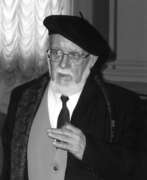

Andrei Andreevich Mylnikov (Russian: Андре́й Андре́евич Мы́льников) was a Russian painter and educator, celebrated for his contributions to Soviet and Russian art. Born in Pokrovsk in 1919, Mylnikov's artistic journey led him to study and later teach at the prestigious Ilya Repin Institute of Painting, Sculpture and Architecture, embodying the spirit of Soviet artistry through his work and mentorship.
Mylnikov's art spans a range of genres, from portraits and landscapes to monumental art. His portraits, such as those of his wife, resonate with harmony and lyricism, drawing comparisons to the Russian Impressionist tradition. Landscapes, like "Summer" (1969) and "Venice" (1964), showcase his ability to blend realism with the symbolic, marked by a fresh palette and pure color. Noteworthy among his creations is the "Farewell" (1975), a painting that captures the emotional gravity of the Soviet people's wartime experiences, and the "Spanish Triptych," which reflects on themes of life, death, and the human spirit, earning him the Lenin Prize.
Mylnikov's works are held in high esteem, finding places in Russia's most prestigious museums and galleries, as well as international collections. His influence extends beyond his canvases, through his significant role in educating future artists and shaping the course of Soviet and Russian art.
For collectors and art enthusiasts, Mylnikov's oeuvre offers a profound glimpse into the soul of Russian art, blending technical mastery with deep emotional and philosophical exploration. His legacy continues to inspire admiration and respect among art lovers around the world.
To stay informed on exhibitions and sales of Andrei Andreevich Mylnikov's works, signing up for updates is highly recommended. This will ensure you're alerted to new opportunities to appreciate or acquire pieces by this remarkable artist, directly related to the primary keyword of interest.
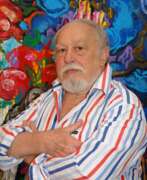

Togrul Farman oglu Narimanbekov (Russian: Тогрул Фарман оглы Нариманбеков) was a distinguished Azerbaijani painter and vocal artist, celebrated as a People's Artist of the USSR and Azerbaijan. Born in Baku in 1930, Narimanbekov's life was marked by the trials of his family during political repressions, which deeply influenced his artistic expressions. He studied monumental and decorative painting at the Lithuanian Institute of Fine Arts, launching a prolific career that spanned across various Soviet republics and European countries.
Narimanbekov's art is known for its vivid color palette and dynamic compositions, capturing the spirit and cultural essence of Azerbaijani life. His works are held in several prestigious collections globally, including the Museum of Modern Art in Germany and the Tretyakov Gallery in Russia. Notable pieces include "Caravanserail at Samarkand" and "Sunny Day," reflecting his mastery in portraying historical and everyday scenes with a lyrical quality.
For those interested in exploring the profound artistic contributions of Togrul Narimanbekov, and to stay updated on exhibitions and sales of his works, consider subscribing to updates on his legacy. This subscription will keep you informed about new discoveries, auction events, and available artworks related to Narimanbekov.


Ben Nicholson, an English artist, is celebrated for his significant contributions to abstract art. Born into an artistic family, Nicholson's work evolved from figurative art to embrace and lead in the development of abstract art in Britain. His early career was marked by experimentation with Cubism and interaction with influential artists like Barbara Hepworth, Henry Moore, Piet Mondrian, and Pablo Picasso, which profoundly shaped his artistic direction.
Nicholson's art is notable for its sensitive balance of tone and texture, employing dynamic and rhythmic lines that abstractly reference architectural forms and societal structures. His technique involved meticulous carving, painting, and the innovative use of color, especially in his later works where he explored the interplay of light and form to create poetic, abstract landscapes. His contributions were not just confined to his own practice; through collaborative projects and influential writings, he played a pivotal role in the discourse of modernist art, advocating for abstract art's broader appreciation.
Noteworthy pieces of Nicholson's work, including "March 1963 (Archimedes)" and "June 1961 (green goblet and blue square)," among others, are housed in prestigious collections like the Tate Gallery, Tate St Ives, Kettle's Yard Art Gallery in Cambridge, The Hepworth Wakefield, Pallant House Gallery in Chichester, and the Pier Arts Centre in Stromness, Orkney.
Nicholson's legacy as a pioneer of abstract art in the UK is secured through his innovative approaches and influential partnerships, which have left an indelible mark on the landscape of 20th-century art. His work continues to inspire and resonate, reflecting a deep understanding of the abstract's power to express the complexities of human experience and the natural world.
For collectors and experts in art and antiques interested in the pivotal movements of 20th-century art, Ben Nicholson's oeuvre offers a rich field of study and appreciation. To stay updated on new product sales and auction events related to Ben Nicholson's work, signing up for updates is a step towards deepening your understanding and appreciation of this key figure in modernist art.
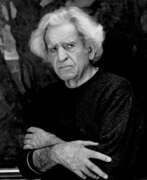

Nikolai Bagratovich Nikoghosyan (Russian: Николай Багратович Никогосян) was a Soviet Armenian sculptor and artist, celebrated for his mastery in creating expressive portraits and monumental sculptures that capture the essence and vitality of his subjects. Born in 1918, Nikoghosyan's art was significantly influenced by the Russian school of realistic sculpture and the national plastics of Armenia, reflecting a unique blend of cultural heritage and artistic innovation.
Throughout his remarkably long career, Nikoghosyan created a vast array of works, including over 200 busts in bronze, wood, and marble, 600 oil paintings, and 3,000 charcoal drawings. His artworks are appreciated worldwide, held in private collections across countries like France, Belgium, and Italy.
Nikoghosyan's significant contributions to art were recognized with numerous titles, including the People's Artist of the Armenian SSR, People's Artist of the USSR, and laureate of the USSR State Prize. His legacy is preserved and celebrated at the Nikoghosyan Cultural Foundation in Yerevan, Armenia, which showcases his sculptures, graphics, and paintings. The foundation not only serves as a tribute to Nikoghosyan's memory but also aims to inspire and support young Armenian artists.
For art enthusiasts and collectors, the work of Nikolai Bagratovich Nikoghosyan offers a fascinating glimpse into the blend of Armenian tradition and Soviet-era artistic expression, making his pieces highly sought after in the realms of both national and international art collections. To stay updated on exhibitions and auction events featuring Nikoghosyan's work, signing up for updates is highly recommended. This ensures you remain informed about opportunities to appreciate or acquire pieces by this master sculptor and artist.


Claes Oldenburg was a Swedish-born American sculptor, celebrated for his groundbreaking contributions to the field of public art and sculpture. With a career spanning over several decades, Oldenburg redefined the boundaries between sculpture and everyday objects, bringing a whimsical yet profound commentary on consumer culture and the urban environment. His talent for transforming the mundane into the monumental made his work not only iconic but also a vital part of the conversation about the role of art in public spaces.
Oldenburg's sculptures are characterized by their colossal scale and imaginative designs, often inspired by everyday items. Perhaps his most famous works include "Clothespin" in Philadelphia and "Spoonbridge and Cherry" in Minneapolis. These pieces are emblematic of his unique approach to sculpture, where familiar objects are reimagined in unexpected contexts, challenging viewers to see the world around them in new ways. His ability to blur the lines between art and life, combined with his playful exploration of form and material, has left an indelible mark on the art world.
For collectors and experts in art and antiques, Oldenburg's works represent not just significant artistic achievements but also compelling investments. His sculptures and installations continue to be celebrated in museums and galleries worldwide, testament to his enduring influence and relevance in the contemporary art scene. For those interested in the intersection of culture, art, and urban life, Oldenburg's legacy offers rich insights and inspiration.
To stay informed about new product sales and auction events related to Claes Oldenburg, we invite you to sign up for updates. This subscription service is designed for collectors and art enthusiasts eager to keep abreast of the latest developments and opportunities in the world of art and antiques. Join us in exploring the remarkable contributions of Claes Oldenburg to the art world.
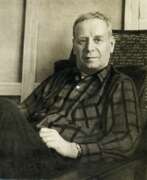

Yuri Ivanovich Pimenov (Russian: Юрий Иванович Пименов) was a distinguished Russian and Soviet painter, renowned for his pivotal role in the "lyrical Thaw" movement within Soviet art. Born in Moscow in 1903, Pimenov emerged as a vital figure in the realm of Soviet impressionism, a title he embraced despite the political and artistic shifts of his time. His unique blend of realism and impressionism, often termed "realistic impressionism," showcased his versatility and defiance against abandoning his creative principles.
Pimenov's journey in the arts was marked by his participation in the OST group and later the "Isobrigade," reflecting his adaptation and response to the evolving Soviet art scene. Despite facing challenges, including a significant psychological crisis in 1931, Pimenov's resilience and dedication to art remained unwavering. His works from this period, characterized by a rose-colored palette and an optimistic view of Moscow, highlight his evolution as an artist and his ability to portray the Soviet reality through a unique lens.
Among Pimenov's notable contributions to Soviet art are masterpieces like "Wedding on Tomorrow Street," "Lyrical Housewarming," and "Japanese Girl Kyoko," each reflecting various facets of Soviet life and Pimenov's personal experiences. These works, celebrated for their vibrant storytelling and intricate details, have solidified Pimenov's legacy as a master of Soviet impressionism.
Pimenov's influence extended beyond the canvas, as he engaged deeply with the world of theater and film, designing sets and posters that further showcased his artistic versatility. His travels abroad, particularly to Japan, enriched his perspective and influenced his later works, demonstrating his global appeal and the universal resonance of his art.
For art collectors and experts, Pimenov's oeuvre represents a unique investment in the history and evolution of Soviet art. His works, a blend of political narrative and personal expression, offer a profound insight into the era of the Soviet Union, making them invaluable pieces for any collection.
To stay updated on new product sales and auction events related to Yuri Ivanovich Pimenov, sign up for our updates. This subscription is your gateway to exploring the rich legacy and enduring impact of Pimenov's art on the Soviet and global art scenes.
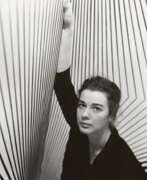

Bridget Louise Riley, an eminent English painter, has captivated the art world with her pioneering contributions to the Op Art movement. Born in London in 1931, Riley's early works were characterized by a figurative, semi-impressionist style. However, her artistic trajectory took a significant turn in the late 1950s and early 1960s when she began experimenting with optical illusions, leading to the development of her signature Op Art style. These works, utilizing geometric patterns in black and white, explored the dynamics of perception, creating disorienting effects and sensations of movement or color in the viewer.
Riley's exploration into color, which commenced in 1967, marked a new phase in her career. Her visit to Egypt in the early 1980s further enriched her palette, leading to the creation of works that reflected the vibrant hues of the Egyptian landscape. This period also saw the introduction of her 'Egyptian palette', which captured both the spirit of ancient and modern Egypt. Notable among her colorful works is "Cataract 3", where Riley utilized the contrast between warm and cold colors to produce a shifting, dynamic effect on the canvas, a testament to her continuous exploration of the interaction between form, color, and human perception.
Riley's work extends beyond canvas, with significant contributions to public art through murals. Her installations at prestigious institutions like the Tate, the Musée d'Art Moderne de la Ville de Paris, and the National Gallery, as well as a large-scale mural for the Chinati Foundation in Marfa, Texas, demonstrate her versatility and commitment to engaging with a broader public audience.
For collectors and experts in art and antiques, Riley's work represents a fascinating intersection of art, science, and perception, offering a unique visual experience that challenges and delights. Her dedication to expanding the boundaries of visual art ensures her place as a central figure in contemporary art discourse.
Sign up for updates related to Bridget Louise Riley to stay informed about new product sales and auction events showcasing her groundbreaking work. Join us in celebrating the legacy and ongoing journey of one of the foremost exponents of optical art.
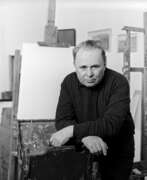

Nikolai Mikhailovich Romadin (Russian: Николай Михайлович Ромадин) was a distinguished Soviet realist painter, celebrated for his profound contributions to landscape painting. Born in 1903 in Samara, Russia, Romadin's artistic journey commenced at the Samara Art College, followed by advanced studies at the Higher Art and Technical Workshops in Moscow under R.R. Falk. A prolific artist from a young age, Romadin's oeuvre spans more than 200 book illustrations, including notable works like Ray Bradbury's "R is for Rocket" and "The Magic Ring" by Andrei Platonov. His distinctive style, which blends realism with elements of surrealism, earned him acclaim and a unique place in art history.
Romadin's personal experiences and travels profoundly influenced his art, with visits to Egypt, Greece, the Netherlands, Italy, and Spain, enriching his perspective and thematic repertoire. Despite his international experiences, Romadin was deeply rooted in his homeland, often expressing nostalgia for Russia. This emotional depth is evident in his landscapes, where the Russian natural world is depicted with a poignant sense of beauty and transcendence.
His legacy is enshrined in the collections of prestigious museums globally, including The State Tretyakov Gallery in Moscow, The State Russian Museum in St. Petersburg, and the Uffizi Gallery in Florence, Italy. Romadin's works have also been celebrated in over 300 solo exhibitions worldwide, underlining his status as a master of Soviet realistic landscape.
For art collectors and enthusiasts, the enduring appeal of Nikolai Mikhailovich Romadin's work lies in its exquisite portrayal of nature and its capacity to evoke profound emotional responses. To stay updated on sales and auction events related to Romadin's art, sign up for updates and immerse yourself in the legacy of this unparalleled artist.
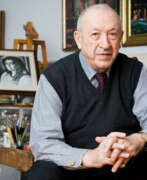

Tahir Salahov (Russian: Таир Теймурович Салахов) was an esteemed Soviet and Azerbaijani painter and draughtsman, celebrated for his pivotal role in the art world. Born in Baku, Azerbaijan, Salahov's journey into the arts commenced at the Azimzade Art College before advancing to the Surikov Moscow Art Institute. Early in his career, his work, particularly "The Shift is Over," garnered significant attention and acclaim, marking his prominence in the art scene.
Salahov's artistry is renowned for its embodiment of the "severe style," a movement within Soviet art in the 1960s that sought to provide a realistic, publicist view in contrast to the polished, idealized portrayal prevalent during the Stalin era. His masterpieces, notably portraits and scenes depicting the life of Baku oil workers, are lauded for their powerful expression and lack of idealization. Salahov's work underwent an evolution over the years, with his later pieces showcasing more peaceful, lyrical contemplations with evident Eastern influences, as seen in "Portrait of Grandson Dan." This transition is marked by smoother lines and a more sophisticated palette, highlighting his versatility and depth as an artist.
Salahov's contributions extended beyond his paintings; he was a key figure in several art academies and organizations worldwide, including the Artists' Union of the USSR and the Russian Academy of Arts. His achievements have been recognized with numerous awards, such as the People's Artist of the USSR and the Order "For Merit to the Fatherland." Salahov's legacy is cemented not only through his artworks but also through his significant impact on the cultural and artistic heritage of Azerbaijan and the broader Soviet and post-Soviet space.
For collectors and art enthusiasts, Salahov's work represents a crucial junction in the narrative of 20th-century art, bridging the gap between realism and the thematic, stylistic diversities of Soviet and Azerbaijani art. His paintings and drawings, many of which reside in prestigious museums, continue to inspire and captivate audiences worldwide.
If you're keen on exploring the life and works of Tahir Salahov further, consider signing up for updates. Subscribers will be alerted to new product sales and auction events related to Salahov's art, ensuring you stay informed about opportunities to engage with the legacy of this monumental artist.
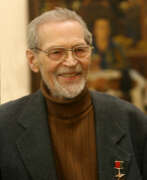

Mikhail Andreyevich Savitsky (Russian: Михаил Андреевич Савицкий) was a Belarusian painter, born on February 18, 1922. His experiences in World War II, where he fought and was imprisoned, deeply influenced his artistic work, leading him to focus on themes of war, struggle, and the human spirit. Savitsky's education in art began after his military service; he graduated from Minsk Art College in 1951 and the Moscow Art Institute of Surikov in 1957. He dedicated much of his life to his craft, becoming a significant figure in Belarusian and Soviet art.
Savitsky is renowned for his powerful depictions of war and its impact on Belarus and its people. His works such as “Partisan Madonna” (1967) and “Leaving in the Night” (1980) are celebrated for their emotional depth and artistic mastery. “Partisan Madonna,” for instance, is viewed as a symbol of Belarusian defense during World War II, portraying a peasant mother as a figure of resilience and protection. On the other hand, “Leaving in the Night” explores the themes of sacrifice and maternal strength during times of conflict, representing the broader struggles faced by Belarus during the war.
Throughout his career, Savitsky received numerous accolades, including the title of People's Artist of the USSR in 1978 and the Hero of Belarus award in 2006. His works are a testament to the resilience of the human spirit in the face of adversity and are housed in various museums and galleries, notably the Minsk State Art Museum and the Gallery of Savitsky in Minsk.
For collectors and experts in art and antiques, Savitsky's oeuvre offers a profound insight into the Soviet and Belarusian artistic narrative, underlined by historical events and personal resilience. His legacy continues to inspire and resonate, providing a window into the experiences that shaped a significant era in Belarusian history.
To stay updated on works and auction events related to Mikhail Andreyevich Savitsky, sign up for updates. This subscription will keep you informed about new product sales and auction events, ensuring you don't miss out on important opportunities related to Savitsky's profound and impactful art.
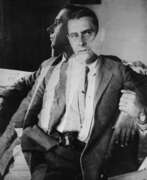

Aleksandr Vasilievich Shevchenko (Russian: Александр Васильевич Шевченко) was a Ukrainian modernist painter and sculptor, whose career spanned from the late 19th to the mid-20th century. Born in Kharkiv in 1882 and passing away in Moscow in 1948, Shevchenko's educational journey took him from private drawing lessons in his youth to prestigious art institutions in Moscow and Paris, where he honed his skills under the tutelage of renowned artists like Valentin Serov and Konstantin Korovin.
Shevchenko's artistic journey was marked by his involvement with avant-garde movements and his contributions to art theory. He explored and experimented with Neo-Primitivism and Rayonism, engaging with the avant-garde community through exhibitions and theoretical works. Notably, his time in Paris allowed him to interact with influential circles that included Mikhail Larionov and members of the Academy Julian.
Shevchenko's legacy is preserved in the Pushkin State Museum of Fine Arts, the State Tretyakov Gallery, and the State Russian Museum, among others. His work from the 1920s onward reflects a blend of experimental and traditional techniques, exploring themes of Russian folk art and oriental influences, which he believed were the origins of Russian art.
For art collectors and enthusiasts, Aleksandr Vasilievich Shevchenko's body of work offers a rich exploration of modernist themes and a bridge between traditional Russian art and avant-garde movements. His contributions to both the practical and theoretical aspects of art make him a pivotal figure in understanding the evolution of Russian modernism.
To stay updated on sales and auction events related to Aleksandr Vasilievich Shevchenko's work, sign up for our newsletter. This subscription will keep you informed about new discoveries and opportunities to acquire pieces by this influential artist.
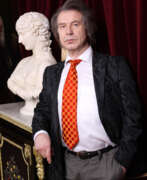

Alexander Maxovich Shilov (Russian: Александр Максович Шилов) is a distinguished Russian portrait painter whose influence spans both the Soviet and contemporary Russian art scenes. Born on October 6, 1943, in Moscow, Shilov's early life was marked by hardship, driving him to work as a loader at just fifteen to support his family. Despite these challenges, his passion for art led him to study at the Surikov Moscow Art Institute between 1968 and 1973, where he honed his skills and developed a distinctive style that would later define his career.
Shilov's artistry is deeply rooted in the tradition of realism, a commitment that he has steadfastly maintained throughout his career. This approach has enabled him to capture the essence of his subjects with remarkable sensitivity and depth. His works often reflect the people and events of his time, from portraits of Soviet cosmonauts and party leaders to tender depictions of ordinary citizens, front-line soldiers, and workers, embodying the spirit and challenges of the era. Notably, his portraits of Soviet leaders and his contributions to ceremonial portraiture have cemented his reputation, while his personal tragedies and responses to social events have added layers of depth to his work.
Shilov's contributions to Russian art have not gone unrecognized. His dedication was honored when an asteroid was named after him in 1992, and in 1996, he generously donated 365 of his portraits to the Russian government. Moreover, his achievements were further acknowledged with the establishment of the Moscow State Art Gallery of People's Artist of the USSR Alexander Shilov in 1997, dedicated solely to exhibiting his works. This gallery, located steps away from the Moscow Kremlin, offers a comprehensive overview of his artistic journey, from early works to those from his mature period.
For art collectors and enthusiasts interested in the rich tapestry of Russian portrait painting, Alexander Shilov's work represents a profound legacy of realism and emotional depth. His paintings not only capture the likeness of his subjects but also the spirit of an era, making them invaluable pieces of cultural and historical significance.
To stay updated on new additions to Shilov's collection and upcoming auction events featuring his work, signing up for updates is highly recommended. This subscription ensures you're informed about the sales and exhibitions of one of Russia's most celebrated portrait painters, Alexander Maxovich Shilov.


Georgy Georgievich Shishkin (Russian: Георгий Георгиевич Шишкин), born on January 25, 1948, is a Russian painter renowned for his unique artistic style that blends traditional Russian themes with modern aesthetics. His work often reflects the subtle inner lives of his subjects, employing a distinctive glazing technique in his pastel works, particularly evident in his depictions of ballet, which beautifully capture the emotional nature of this art form.
Educated at the Ural State Academy of Architecture and Arts in Yekaterinburg, Shishkin has had a prolific career with exhibitions across Russia and Europe. He is perhaps best known for his "Russian Dreams" series, initiated in 1992, which explores the spiritual essence of Russian identity through a fusion of the abstract and the real. Shishkin's accolades include winning the Taylor Foundation Prize in 1999, affirming his significant impact on contemporary art.
Shishkin has also contributed to the design of postage stamps for Monaco, including the effigy of H.S.H. Prince Albert II, further demonstrating his versatility and the international recognition of his artistry. His works have been displayed in prestigious venues such as the State Russian Museum and have garnered international attention, with pieces sold at major auction houses like Christie's.
If you're fascinated by the artistic journey of Georgy Shishkin and wish to stay updated on his latest exhibitions, works, and auction events, consider signing up for our exclusive updates. This subscription is your gateway to the vibrant world of Shishkin's art, ensuring you never miss a chance to view or acquire his compelling creations. Sign up here for timely updates directly related to Georgy Shishkin's art sales and exhibitions.
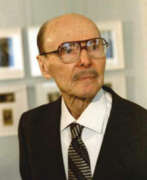

Dementy Alekseyevich Shmarinov (Russian: Дементий Алексеевич Шмаринов) was a prolific Russian graphic artist, illustrator, and teacher, whose work left an indelible mark on the world of art. Born in Kazan in 1907, he moved through various phases of education and artistic development, from his early lessons with N.A. Prakhov in Kiev to his formative years at the studio of D.N. Kardovsky in Moscow. Shmarinov’s work spanned a broad range of subjects, but he is perhaps best remembered for his contributions to illustrating classic literature and his poignant depictions of the Soviet Union during World War II. His illustrations for novels by Dostoevsky and Tolstoy, among others, are celebrated for their depth and detail, effectively capturing the essence and atmosphere of the literary works they accompany.
During World War II, Shmarinov's art took a decidedly patriotic turn as he created wartime political posters and a series of graphic works reflecting the suffering and resilience of the Soviet people. His collection "We Won’t Forget, We Won’t Forgive!" exhibited at the Tretyakov Gallery in Moscow, garnered significant attention for its raw depiction of the horrors of war and earned him the State Prize of the USSR in 1943. His contributions were not only limited to times of conflict; Shmarinov was deeply involved in the Soviet art community, serving as chairman of the Moscow Union of Artists and as a member of the USSR Academy of Arts, where he influenced generations of artists with his astute observations and dedication to the craft.
Shmarinov's legacy is not merely in his artworks but also in his role as an educator and mentor, shaping the future of Russian art through his teachings and organizational skills. His ability to convey complex characters and scenes with striking clarity and emotional depth made him a revered figure in Soviet and Russian art. His works continue to be celebrated, offering insights into the cultural and historical context of his times.
For collectors and experts in art and antiques, Dementy Alekseyevich Shmarinov remains a figure of immense importance. His illustrations and graphic works are not only aesthetically compelling but also historically significant, reflecting the tumultuous periods through which he lived. To stay updated on sales and auction events related to Shmarinov's work, signing up for updates is a wise move for enthusiasts eager to explore the depths of Russian art and history.
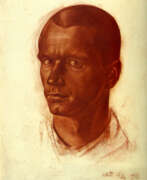

Vasily Ivanovich Shukhaev (Russian: Василий Иванович Шухаев) was a multifaceted Russian and Soviet artist, celebrated for his expertise as a painter, graphic artist, stage designer, and teacher. Born in Moscow in 1887, Shukhaev's artistic journey began at the Imperial Stroganov School of Industrial Art, where he was under the tutelage of prominent artists like K. A. Korovin and I. I. Nivinsky. His education continued at the St. Petersburg Academy of Arts, which paved the way for his diverse and influential career. Shukhaev's body of work is vast, encompassing hundreds of paintings, drawings, theater sketches, book illustrations, and monumental works, showcasing a deep engagement with genre paintings, still lifes, landscapes, and portraits.
Shukhaev's legacy includes a significant period of creativity and teaching in Paris in the early 20th century, after leaving Russia post-October Revolution. His Parisian phase was marked by innovative book illustrations for renowned literary works by Pushkin, Gogol, Dostoevsky, and others, demonstrating his unique ability to blend literary themes with visual artistry. Notably, his illustrations for Pushkin's "Queen of Spades" and "Boris Godunov" stood out for their stylistic nod to vintage prints and the emblematic use of symbols.
His art has been celebrated in various international exhibitions and is held in high regard by collectors and museums alike. Works such as "The Reigning Monarchs of the World" (1934), a group caricature published in Vanity Fair, reflect Shukhaev's versatile style and ability to capture the essence of his subjects with a mix of reverence and subtle critique.
For art collectors and enthusiasts interested in Russian and Soviet art, Vasily Ivanovich Shukhaev's oeuvre represents a bridge between classical traditions and modern artistic expressions. His work continues to captivate audiences with its historical depth, technical brilliance, and emotive power.
If you're keen on exploring more about Vasily Ivanovich Shukhaev's works or wish to stay updated on sales and auction events featuring his art, signing up for updates is a step towards immersing yourself in the rich tapestry of Russian art history.
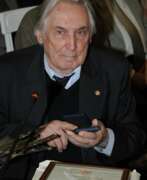

Valentin Mikhailovich Sidorov (Russian: Валентин Михайлович Сидоров) was a distinguished Russian painter, teacher, and a significant figure in the art world, celebrated for his profound contributions to Russian landscape painting and his role in art education. Born in 1928 in Sorokopenie, Tver Gubernia, Sidorov's early education in art took place at notable institutions such as the Moscow Palace of Pioneers, the Moscow Secondary School of Art, the Ilya Repin Institute of Painting, Sculpture and Architecture, and finally, the Vasily Surikov Institute of Art in Moscow. His transition to the Surikov Institute marked a pivotal point in his career, allowing him to develop a unique approach to landscape painting.
Sidorov's career was defined by his dedication to capturing the essence of the Russian landscape, often veering away from the ideological demands of the times to paint what resonated with his soul. His early works from the "Korovino" series, including "Stormy Day. Korovino" and "Morning in the Hut," are celebrated for their delicate execution and ability to evoke the artist's emotional experiences through common scenes of nature and village life. His contributions to the genre were further solidified during his time at the "Academic Dacha," where his engagement with plein-air painting deepened his exploration of pictorial form and composition.
Throughout his illustrious career, Sidorov received numerous accolades, including the title of People’s Artist of the USSR, the Ilya Repin State Prize, and the State Prize of Russia. His works have been included in the collections of prestigious institutions such as the Russian Museum, where pieces like "Bell. Silence" and "In the Beginning of May" are held. Sidorov's paintings are admired for their lyrical quality, depth, and the masterful way they communicate the beauty of the Russian landscape.
For collectors and experts in art and antiques, Valentin Mikhailovich Sidorov's works represent a unique blend of Russian heritage, emotional depth, and artistic mastery. His legacy continues to inspire and influence the world of Russian art.
If you're passionate about exploring the works of Valentin Mikhailovich Sidorov or wish to stay updated on upcoming sales and auction events featuring his art, consider signing up for updates. This subscription will ensure you're always in the know about new opportunities to appreciate or acquire pieces by this remarkable artist.
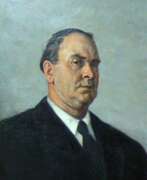

Pavel Petrovich Sokolov-Skala (Russian: Павел Петрович Соколов-Скаля) was a prominent Russian artist, celebrated for his contributions to Soviet art and culture. Born in 1899, Sokolov-Skala's artistic journey was marked by his affiliation with the Communist Party of the Soviet Union, reflecting the political landscape of his time through his work. His legacy includes receiving prestigious awards like the Stalin Prize and the Medal "For Valiant Labour in the Great Patriotic War 1941–1945", acknowledging his influence and contribution to Russian art and history.
Sokolov-Skala's oeuvre is notable for its diversity, ranging from monumental historical paintings to poignant war posters, demonstrating his versatility and mastery across different mediums. His works, such as "The Clear Glade" and "A Heroic Deed of Captain Gastello," are celebrated for their powerful portrayal of Soviet themes, capturing the spirit and challenges of his era. These pieces not only underscore Sokolov-Skala's artistic prowess but also his commitment to depicting the Soviet Union's ideals and narratives.
His paintings and posters, often characterized by their bold use of color and dramatic compositions, provide insight into the socio-political context of the 20th century Soviet Union, making him a key figure in Russian art history. Despite his significant role, Sokolov-Skala's work invites audiences to explore the nuanced intersections of art, politics, and history, offering a complex portrait of Soviet life.
Collectors and experts in art and antiques have continuously shown interest in Sokolov-Skala's works, highlighting their historical value and artistic merit. His contributions remain a focal point of study and appreciation within both Russian and international art circles.
For enthusiasts looking to delve deeper into the world of Pavel Petrovich Sokolov-Skala or to add a piece of his legacy to their collection, signing up for updates can provide exclusive access to new product sales and auction events featuring his work. This is a unique opportunity to engage with the rich history and profound impact of Sokolov-Skala's art on contemporary culture.
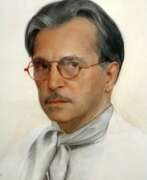

Saveliy Abramovich Sorin (Russian: Савелий Абрамович Сорин) was a Russian painter renowned for his exceptional portrait works. Born in 1878 in Polotsk, Vitebsk province, into a modest Jewish family, Sorin's journey in art took him from Russia to the West, notably France and the USA, where he established himself as a distinguished portraitist by the early 20th century. His education at the Academy of Fine Arts, under the guidance of illustrious teachers including Ilya Repin, laid a strong foundation for his career. Sorin's talent for capturing the essence of his subjects through graceful and precise imagery won him acclaim and a diverse clientele, ranging from aristocrats and royals to fellow artists and cultural figures.
Throughout his career, Sorin lived and worked across various locales, including St. Petersburg, the Crimea, Tiflis, France, and the United States, reflecting a life marked by both artistic and geographic exploration. His notable works include portraits of prominent Russian cultural figures such as Maxim Gorky, Fyodor Chaliapin, Anna Akhmatova, and Tamara Karsavina, showcasing his ability to capture the spirit of Russian culture through his art. Sorin's works are a testament to his skill in combining the richness of color with precise drawing, achieving a remarkable likeness in his portraits.
Saveliy Abramovich Sorin's legacy is preserved in his contributions to art, with many of his pieces donated to museums in the USSR, alongside those held in private collections and museums worldwide. His life and work exemplify the journey of a talented artist navigating the challenges of his time, leaving behind a rich portfolio that continues to captivate and inspire.
For collectors and art experts intrigued by Sorin's legacy and the unique charm of his portraits, staying updated on related sales and auction events is essential. Signing up for updates on Saveliy Abramovich Sorin ensures you remain informed about new opportunities to explore and acquire works by this remarkable artist, enriching your collection with pieces that embody the elegance and depth of early 20th-century Russian portrait art.
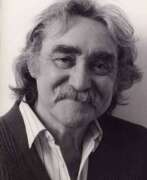

Jesús Rafael García Soto was a Venezuelan artist, renowned for his pioneering work in kinetic and op art, which sought to create an immersive experience that blurred the lines between the artwork and the viewer. Born in 1923, Soto embarked on a journey that would see him at the forefront of a movement that emphasized the visual dynamics of art, integrating sculpture, painting, and viewer participation in novel ways. His exploration of geometric abstraction and optical effects led to the development of his distinctive style, characterized by the use of materials such as plexiglass to create engaging optical illusions and vibrant, moving sculptures.
Soto's journey into the realms of kinetic art was marked by significant milestones, including his participation in the groundbreaking 1955 exhibition, Le Mouvement, at the Denise René gallery in Paris. This event was instrumental in defining the kinetic art movement, with Soto alongside artists like Yaacov Agam, Marcel Duchamp, and Victor Vasarely, presenting works that invited viewers to experience art in a dynamic, interactive manner. His quest for a new visual language led him to experiment with the dematerialization of form, creating artworks that seemed to dissolve into their surroundings, thereby challenging the viewer's perceptions of space and form.
Throughout his career, Soto remained dedicated to exploring the intrinsic relationships between space, movement, and viewer perception. His creations, ranging from the "Penetrables" series—immersive environments made of hanging strands that visitors could walk through—to large-scale murals and public sculptures, have been celebrated worldwide. His works are part of major collections and have been exhibited extensively, including at institutions such as the Museum of Modern Art in New York and the Tate Gallery in London, demonstrating his lasting influence on contemporary art.
For art collectors and enthusiasts intrigued by the fusion of art and motion, Jesús Rafael García Soto's work offers a profound exploration of the kinetic art movement's possibilities. His contributions to art are not just visual spectacles but invitations to engage directly with the kinetic energy and vibrancy of the world.
To stay updated on exhibitions and sales featuring Jesús Rafael García Soto's work, sign up for updates. This subscription ensures you're informed about new product sales and auction events related to this visionary artist, offering unique opportunities to experience the dynamism of kinetic art firsthand.
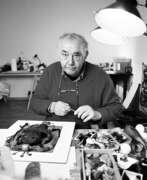

Daniel Spoerri was a Swiss artist of Romanian-Jewish descent, renowned for his contributions to the art world as a key figure in the Nouveau Réalisme (New Realism) movement. Born in Romania in 1930, Spoerri made significant strides in visual art, particularly in his development of "snare-pictures," a method where he captured a group of objects, such as table settings and the remnants of meals, in a state of apparent disorder yet meticulously fixed to the tabletop.
His works are celebrated for turning ordinary moments into a tableau of frozen time, capturing life's ephemeral qualities through the permanence of art. Notably, his piece "Tableau piège" involves the fixation of objects to a board or table, which is then displayed vertically, challenging traditional art display norms and viewer perceptions. This innovative approach allowed him to explore themes of consumption, waste, and the mundane, making the everyday profound.
Daniel Spoerri's art is housed in many esteemed institutions, including the Museum of Modern Art in New York and the Centre Georges Pompidou in Paris. His work continues to influence contemporary art, offering a unique perspective on the art of assemblage and the beauty in the banal.
For those interested in exploring more about Daniel Spoerri's life and works, or in keeping updated with sales and auction events related to his art, signing up for our updates is highly recommended. This subscription ensures you stay informed about the latest offerings and exhibitions featuring Spoerri's intriguing creations.
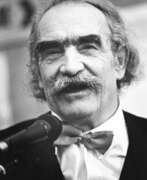

Jean Tinguely, a Swiss sculptor born in Fribourg, Switzerland, in 1925, carved a unique niche in art history with his kinetic sculptures, integrating movement and self-destruction into his works. Notably, his pieces extend the Dada tradition into the latter part of the 20th century, satirizing automation and the technological overproduction of material goods. Tinguely's innovative approach is exemplified in his Metamatic drawing machines, allowing viewers to create abstract images automatically, and his spectacular self-destroying sculpture "Homage to New York" at MoMA in 1960, showcasing his flair for blending performance and art.
His artistry evolved through collaboration with other artists, including his wife Niki de Saint Phalle, leading to vibrant, large-scale projects like the colorful "Stravinsky Fountain" near the Centre Pompidou in Paris. Tinguely's works, characterized by their use of scrap metal and mechanical parts, not only challenge the conventional boundaries of art but also engage with themes of destruction, renewal, and the intersection of art and life. His significant contributions to kinetic art and his involvement with the Nouveau Réalisme group highlight his pioneering role in post-war European art.
Tinguely's legacy is preserved in the Museum Tinguely in Basel, dedicated to his life and work, ensuring his innovative spirit continues to inspire. His works, such as "Méta-Harmonie" and the "Carnival Fountain" in Basel, remain influential, blending artistic exploration with mechanical invention.
For art collectors and experts, Tinguely's creations represent not only significant artistic achievements but also compelling investments, as his works continue to command high prices at auctions, reflecting their enduring appeal and historical importance.
To stay updated on sales and auction events featuring Jean Tinguely's art, sign up for updates. This subscription will ensure you're informed about new opportunities to explore and acquire pieces by this visionary artist, bringing the dynamic energy of kinetic art into your collection.
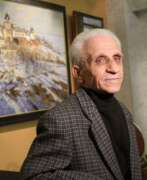

Aleksey Petrovich Tkachyov (Russian: Алексей Петрович Ткачёв), born on September 11, 1925, in Bryansk, USSR, was a Soviet and Russian artist and educator renowned for his contributions to graphic art and painting. His artistic journey, marked by collaboration with his older brother Sergei Tkachyov, led to the creation of a distinctive tandem known as the Tkachev Brothers. Their collective works, encompassing genre paintings, portraits, landscapes, and still lifes, are celebrated for embodying the essence of contemporary Russian art and socialist realism. This unique partnership yielded a multitude of canvases that have been integrated into the "golden" fund of Russian painting, with themes ranging from historical events to everyday life, reflecting the brothers' profound connection to their cultural heritage.
The Tkachev Brothers' oeuvre, notable for its rare focus on genre art within the context of modern Russian art, has achieved significant acclaim and demand. Their paintings are featured in leading Russian museums and have found places in private collections across the globe, including in Belgium, Britain, Germany, Italy, Canada, China, the Netherlands, USA, Taiwan, France, South Korea, and Japan. This widespread recognition underscores the universal appeal and historical significance of their work, bridging cultural and geographical divides through the universal language of art.
For collectors and experts in art and antiques interested in the legacy of Aleksey Petrovich Tkachyov and the Tkachev Brothers, their work represents not only an investment in fine art but also a connection to the rich tapestry of 20th-century Russian culture and history. To stay updated on new product sales and auction events related to Aleksey Petrovich Tkachyov, signing up for updates is highly recommended. This ensures access to exclusive information on available works and upcoming collections, allowing enthusiasts to further explore and appreciate the profound impact of the Tkachev Brothers on contemporary art and society.
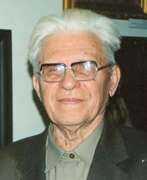

Sergey Petrovich Tkachyov (Russian: Сергей Петрович Ткачёв), born in 1922 in the Chugunovka, Bryansk region of Russia, is a prominent figure in the Russian art scene, celebrated for his evocative village figure and genre paintings. Educated at the Surikov Institute in Moscow, Tkachyov graduated in 1952 and, alongside his brother Aleksei, has captured the essence of rural life in Russia through their art for over six decades. The brothers, sharing studios in both Moscow and the countryside, have collaboratively worked on many pieces, often on the same canvas, which has led them to be awarded prestigious titles such as "People's Artist of the USSR" and receiving accolades like the USSR State Prize and the Repin Prize of the Russian Federation .
Tkachyov’s works are notable for their deep narrative quality and emotional depth, focusing on genre and characterization. His early sketches, such as “A Lonely Fisherman” from 1948, evolved into more complex compositions like “Kids” created between 1958 and 1960, showcasing his ability to weave stories through his art. His and his brother's early works, influenced by the likes of Valentin Serov and Konstantin Korovin, laid a foundation for their unique artistic language that emerged in the late 1950s. This period marked the creation of significant works, differing in style but united in their rich narrative and visual texture.
Among the celebrated works of Tkachyov is “On the High Point,” which pays homage to the valor of soldiers during World War II, encapsulating the tension and heroism of a nocturnal assault on an enemy position. Another notable piece, “Portrait of Atamanov,” completed in 1995, delves into the personal, portraying a war veteran in a ceremonial style that meticulously captures the details of military honors, reflecting Tkachyov's own experiences and connections forged during the war. Additionally, “The School in Ovstug,” painted in 1984, is a historical piece reflecting on the educational legacy in a village, symbolizing the broader cultural and social narratives that Tkachyov seeks to preserve through his art.
Sergey Tkachyov’s body of work stands as a profound chronicle of Russian rural life and its people, marked by a dedication to realism, emotive storytelling, and a deep connection to the country’s history and culture. His paintings not only celebrate the beauty and hardship of rural Russia but also serve as a reminder of the nation's complex historical tapestry, making them invaluable to collectors and experts in art and antiques.
To stay updated on exhibitions and sales featuring the captivating works of Sergey Petrovich Tkachyov, sign up for our newsletter. This subscription will ensure you are the first to know about new product sales and auction events related to this esteemed artist.


Moses Ivanovich Toidze (Russian: Моисей Иванович Тоидзе) was a distinguished Georgian Soviet artist and educator, known for his significant impact on art during the early to mid-20th century. Born and passed away in Tbilisi (February 2, 1871 - June 17, 1953), his life and work mirrored the substantial cultural shifts of his time. His contributions spanned various genres, including genre art, historical painting, landscape painting, and portraiture, showcasing his versatility and deep connection to the Georgian cultural identity.
Toidze's career was also marked by his dedication to art education. As a professor at the Tbilisi Academy of Arts and the founder of a public art studio in Tbilisi in 1922, he played a pivotal role in establishing the foundations of professional art education in Georgia. This commitment to nurturing talent influenced countless Georgian artists, enriching the nation's artistic heritage.
His body of work reflects a profound engagement with Georgian life, capturing its landscapes and people with emotional depth and nationalistic pride. Notable works like "Market (Bazazkhana)" (1914), "Landscape" (1918), and "King Tamar in the Country-Cottage" (1919) exemplify his skill in blending realism with emotive storytelling.
Preserving Toidze's legacy, the Mose Toidze House Museum, established in his former home and studio, curates a vast collection of his artworks alongside photographic and documentary materials. This museum offers a comprehensive look into his life, work, and the cultural backdrop that influenced him.
For art collectors and experts, Moses Ivanovich Toidze remains a central figure in modern Georgian painting, whose work and influence persist in inspiring current and future generations. Staying informed about sales and auction events related to Toidze's work is essential for those looking to immerse themselves in or acquire pieces of this master's enduring legacy.
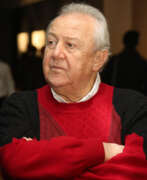

Zurab Konstantinovich Tsereteli (Russian: Зураб Константинович Церетели), a Georgian-Russian artist renowned for his monumental sculptures, has left an indelible mark on the landscape of modern art. Born in Tbilisi in 1934, Tsereteli expanded his artistic vision beyond painting after moving to Paris in the 1960s, where he was influenced by luminaries such as Picasso and Chagall. His work is characterized by a blend of dramatic, unconventional styles that have spurred debate but undeniably contributed to the cultural fabric of cities around the world.
Tsereteli's artworks, ranging from sculptures to paintings, are displayed globally, embodying his ethos that "art unites people." Noteworthy projects include the Peter the Great statue in Moscow, the Birth of the New Man in Seville, Spain, and the Tear of Grief in Bayonne, New Jersey, a poignant memorial to the victims of the 9/11 attacks. His commitment to fostering international cultural exchanges is evident in his role as the President of the Russian Academy of Arts and a UNESCO Goodwill Ambassador.
Beyond his public commissions, Tsereteli's contributions to education and the arts are profound. He founded the Moscow Museum of Modern Art and the Museum of Modern Art in Tbilisi, promoting modern and contemporary art in Russia and Georgia. His dedication to the Russian Academy of Arts underscores his belief in the importance of nurturing artistic talent and preserving the heritage of the academic school of fine arts.
For collectors and experts in art and antiques, Tsereteli's oeuvre offers a unique investment in pieces that are not only visually striking but also rich with cultural significance. His work encapsulates the dynamic interplay between traditional and contemporary art forms, making each piece a testament to his lifelong dedication to artistic innovation and cross-cultural dialogue.
To stay updated on new exhibitions, sales, and auction events related to Zurab Konstantinovich Tsereteli, sign up for updates. This subscription is a gateway to the latest developments in the world of a towering figure in art, offering exclusive insights into his ongoing contributions to the global art scene.
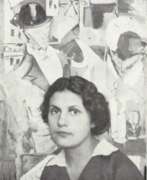

Nadezhda Andreevna Udaltsova (Russian: Наде́жда Андре́евна Удальцо́ва) was a Russian avant-garde artist known for her contributions to Cubism and Suprematism and her participation in the avant-garde movement of pre-revolutionary Russia. Udaltsova was born into an officer's family in Orel, western Russia, on December 29, 1886, and died on January 25, 1961, in Moscow, USSR. Udaltsova was deeply influenced by French Cubism, which she encountered in the art collection of Sergei Shchukin. This encounter was a decisive turning point in her artistic path, leading her to post-impressionism and then to avant-garde art forms.
After the 1917 revolution, her art was recognized by the new regime. Udaltsova played a significant role in education, as a professor and senior lecturer at VKhUTEMAS, the Higher Art and Technical Workshops, and a member of the Institute of Artistic Culture (Inhuk). Despite hardships, including the NKVD's execution of her husband Alexander Drevin in 1938, and becoming persona non grata in Soviet art circles, she continued her artistic endeavors, holding a solo exhibition in 1945 and participating in a group exhibition in 1958.
Udaltsova's legacy is remarkable not only for her artistic achievements, but also for the challenges she overcame. Her work is in prestigious collections, including the Museum of Modern Art (MoMA), attesting to her indelible impact on the art world.
For those interested in learning more about Nadezhda Andreevna Udaltsova's work and life, it will be helpful to visit the museums that house her works or subscribe to our newsletters about exhibitions and auctions featuring her art. This will allow a deeper understanding of this remarkable artist's contribution to the avant-garde movement and the art world in general.


Boris Sergeevich Ugarov (Russian: Бори́с Серге́евич Уга́ров) was a distinguished Russian Soviet realist painter and art educator, whose contributions to the Leningrad school of painting marked him as one of its most illustrious representatives. Born on February 6, 1922, and passing away on August 2, 1991, Ugarov's life and work were deeply intertwined with the cultural and artistic developments of his time, earning him the status of an Honored Artist of the RSFSR. His paintings, celebrated for their depth and realism, captured the essence of Soviet life and ideology, reflecting the socio-political atmosphere of the era.
Ugarov's career was distinguished not only by his artistic talent but also by his dedication to art education, influencing generations of artists as a professor and rector at the prestigious Academy of Arts. His contributions to the Russian and Soviet art scenes were recognized with numerous awards, including the State Prize of the USSR, illustrating his impact on and legacy within the realm of Soviet art. Ugarov's works, which are held in high regard both nationally and internationally, can be found in museums and private collections, serving as a testament to his skill and dedication to realism.
For collectors and experts in art and antiques, the works of Boris Ugarov offer a unique glimpse into the Soviet era, characterized by meticulous attention to detail and a profound understanding of the human condition. His legacy continues to inspire and influence, underscoring the importance of realism in conveying cultural and historical narratives. For those interested in exploring the rich tapestry of Russian Soviet art, Ugarov's work remains a pivotal point of reference.
To stay updated on new product sales and auction events related to Boris Sergeevich Ugarov, sign up for updates. This subscription ensures you remain informed about opportunities to acquire pieces by this master of Soviet realism, bringing the depth and beauty of his work into your collection.


Stepan Petrovich Yaremich (Russian: Степан Петрович Яремич) was a multifaceted Ukrainian artist and art historian, whose career spanned the late 19th and early 20th centuries. His profound contributions to art history and preservation, particularly during the tumultuous post-revolutionary period in Russia, underscore his significance beyond his work as a painter. Yaremich's expertise in Western European drawing, bolstered by his years in Paris where he amassed an impressive collection featuring masters like Watteau and Fragonard, highlighted his remarkable connoisseurship.
Educated in Kiev and Paris, Yaremich was associated with the "World of Art" movement and worked closely with figures like Alexandre Benois. He was not just an artist but a respected art expert, often involved in the restoration and cataloging of Russian and Western European art. His time at the Hermitage and Russian Museum showcased his dedication to art preservation, contributing significantly to the fields of art history and conservation.
Yaremich's artistic legacy includes landscapes of St. Petersburg, Venice, and other locales, characterized by a unique approach to color and form that distinguished his work from his contemporaries. Despite the critical acclaim, it was his behind-the-scenes work as an art historian and conservator that solidified his enduring impact on the art world.
Collectors and experts in art and antiques will find Yaremich's work both compelling and significant, underlining the importance of not only creating art but also preserving it for future generations. For updates related to Stepan Petrovich Yaremich, including sales and auction events, sign up for our newsletter. This subscription will keep you informed about the latest findings and opportunities to acquire works associated with this remarkable figure in art history.


Konstantin Fyodorovich Yuon (Russian: Константи́н Фёдорович Юо́н) was a distinguished Russian artist and painter, celebrated for his multifaceted contributions to the world of art. Born in Moscow, Yuon's work spans painting, stage design, and teaching, making significant impacts across these fields. His artistry is renowned for blending traditional Russian motifs with innovative techniques, illustrating the rich tapestry of Russian culture and history.
Yuon's masterpieces are characterized by their vibrant use of color and light, capturing the essence of Russian landscapes and urban scenes with a unique lyrical quality. His notable works, such as "New Planet" and "The March Sun," showcase his ability to transcend the ordinary, offering viewers a glimpse into the ethereal beauty of everyday life. These pieces not only highlight his technical prowess but also his profound understanding of the emotional and cultural significance of his subjects.
Throughout his career, Yuon's influence extended beyond the canvas, as he nurtured the next generation of artists through his teaching. His dedication to the arts was recognized with prestigious awards, affirming his status as a pillar of the Russian art community. Today, his works are preserved in major museums and galleries, serving as a testament to his enduring legacy in the fields of painting and cultural heritage.
For collectors and experts in art and antiques, the legacy of Konstantin Fyodorovich Yuon offers a fascinating exploration into the evolution of Russian art. His works not only represent significant artistic achievements but also embody the cultural and historical narratives of their time. To stay informed on new product sales and auction events featuring Yuon's work, we invite you to sign up for updates. This subscription will ensure you're always in the loop on opportunities to own a piece of Russian art history.
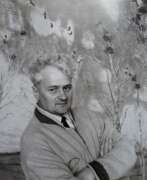

Vecheslav Frantsevich Zagonek (Russian: Вячесла́в Фра́нцевич Заго́нек) was a distinguished Soviet painter, celebrated as a People's Artist of the USSR and a luminous figure within the Leningrad school of painting. Born on December 19, 1919, in Irkutsk, East Siberia, Zagonek's journey into the arts took him to Leningrad, where he honed his skills at the prestigious Secondary Art School under the All-Russian Academy of Art and later at the Repin Institute. His art, known for its lyrical landscapes and evocative genre paintings, carried the essence of his homeland's beauty and its people's spirit. Zagonek's contributions to art were recognized with his membership in the Academy of Arts of the USSR, and his works are held in high esteem, displayed in prominent Russian museums like the State Russian Museum and the State Tretyakov Gallery, as well as in international collections.
Throughout his career, Zagonek exhibited a profound ability to capture the Russian landscape and everyday life, rendering them with a depth of feeling and a nuanced palette that spoke to the soul of the viewer. His works from various periods, including notable pieces like "Girl with a horse" and "Village Vella. Snowdrift," have been highly valued at auctions, reflecting the enduring appeal and significance of his art.
Zagonek's legacy extends beyond the borders of Russia, with his paintings residing in museum collections worldwide, underscoring his role as a key ambassador of Soviet art on the global stage. His dedication to his craft earned him prestigious accolades, including the title of People's Artist of the USSR, and placed him among the esteemed members of the Russian Academy of Sciences.
For art collectors and enthusiasts, the works of Vecheslav Frantsevich Zagonek offer a unique glimpse into the soul of Russian art, embodying the beauty, complexity, and spirit of his time. To stay informed on upcoming sales and auction events featuring Zagonek's work, consider signing up for updates. This exclusive subscription will ensure you're among the first to know when new pieces become available, allowing you to add a piece of Russian art history to your collection.




